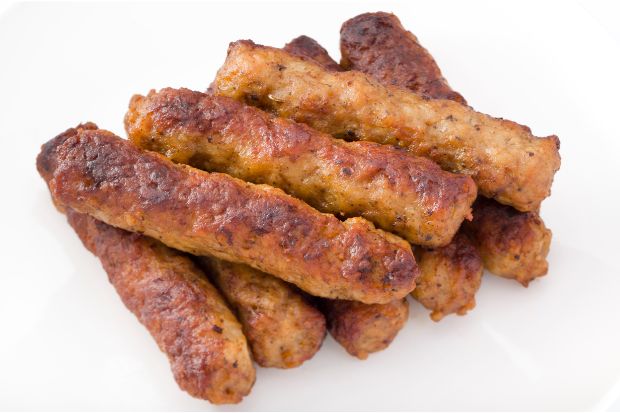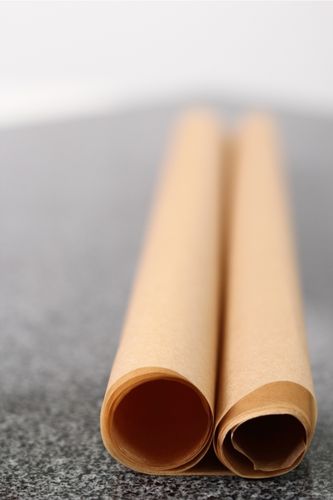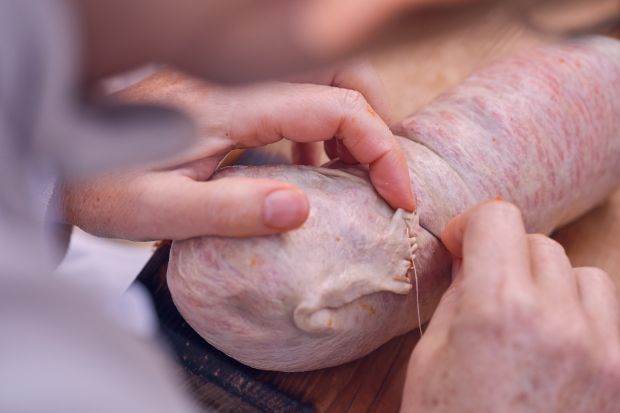If you need a substitute for sausage casings, there are many great alternative options to choose from. In addition to a wide range of synthetic and natural sausage casings to try, you can use caul fat, Saran wrap, muslin, or even make a skinless sausage instead!
No Sausage Casings? Try Sausage Without Casings!

Not all traditional sausages are meant to be held in a case. No sausage casing at all is an option! Skinless sausages can be made by forming your sausage into its regular shape, then chilling it well to help it hold its shape during cooking. Be sure to add lots of fat to your sausage mix, as a lot of moisture will be lost in the cooking process if you choose this option.
You may also consider forming your sausage into a patty shape for the grill if you are worried that a skinless sausage shape won’t stay intact. If you’re out of your regular sausage casings, a sausage with no casing may be worth trying!
Saran Wrap as a Sausage Casing
Obviously, this isn’t designed to be eaten, but if you’re out of sausage casings, one option is to roll your sausage by hand in commercial-grade Saran wrap (check that it is heatproof so that it won’t melt), then leave it in the fridge to firm up before gently poaching in water to help them hold their shape.
The quality of plastic wrap is important here, so check the packaging. Wraps made of polyvinyl chloride (PVC) or polyvinylidene chloride (PVDC) could potentially leach chemicals into your sausage. You will need a high-quality plastic wrap made from polyethylene or polypropylene. Saran wrap and Glad wrap both qualify.
Don’t boil the water, as this will damage the sausage’s structure. Once they have been lightly poached and are partly cooked, they can then be fried or grilled with the Saran wrap removed. If you choose this sausage casing option, you may wish to add a binding ingredient such as a beaten egg or some breadcrumbs to your sausage mix to help keep the sausage from falling apart.
Foil or Baking Parchment as a Sausage Casing

Much like the Saran wrap method above, aluminum foil or baking parchment can also be used as a substitute for sausage casing. As water is more likely to leak into these types of substitute sausage casings if they are poached, try steaming them to pre-cook them instead.
Caul Fat as a Sausage Casing

One natural substitute for sausage casings that is completely edible is caul fat. This flat sheet of membrane holds the animal’s internal organs in place and is often sold by butchers. Also called lace fat, this can be a perfect replacement for sausage casings but will require you to make, roll and wrap the sausages by hand rather than by machine.
The caul fat-wrapped sausage can then either be cooked like a parcel or tied with cooking string at each end to preserve the shape and integrity of the sausage. Remove the string before serving. Caul fat is used by many fine-dining chefs as a substitute for sausage casing, as the fat content keeps the inner filling moist and juicy and prevents it from drying out during cooking.
Muslin Sausage Casings
This might take some home-crafting skills to perfect, but you can make a substitute for sausage casing using muslin cloth. Begin by taking a large rectangle of muslin and cutting and stitching tube shapes around 1 1/2 inches in diameter. These tubes can then be filled using a regular sausage-making machine, and you can tie off links as you would with regular sausage casings. The sausages can then be cooked normally. Remove the casing before serving.
Alternative Sausage Casings
There is also a wide range of vegetarian and vegan sausage casings that you may wish to try, such as those made from synthetic materials (many of these need to be removed before cooking) or made from the cellulose of plant-based collagen.
